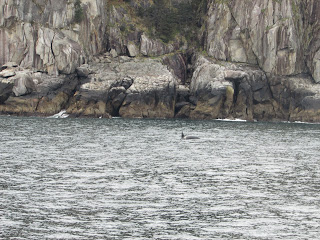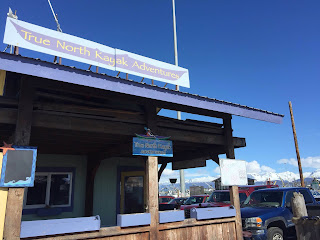Day 5: Impromptu Free Day!
The water was a little too rough today for half of our group
to go deep-sea fishing. So, for our impromptu free-day, we had a couple of
rounds of trips to The Homer Spit, a quaint boating and fishing village with
the cutest little shops. The small group that we were with stopped into Captain
Patties for a quick bite to eat. Upon looking at the menu, we determined that
it was a little classier than we were prepared for and just ordered a couple of
appetizers… which were delicious. The view wasn’t too bad either:
Abby W. and Katie G.
Day 6: Gone Fishing!
Today the waters in Cook Inlet cooperated enough to get
eight members of the group into a couple of boats and head out to do some deep
sea fishing. Our group was led out by a couple of local fishermen to a few
spots they were sure we could catch some descent sized salmon and halibut. The
ride out was a little frigid, so luckily there was plenty of room in the cabin
to keep warm. After a short ride out, we found a spot and started fishing.

Deep sea fishing was different than either of us had
experienced. Rather than holding onto and casting the pole as is done with
fresh water fishing (which we had both done plenty of times before), the pole
was set into a holder and the bait, green herring in this case, was cast down
into the water using a submerging device. After the herring was submerged, we
sat (or stood) and waited, watching the pole for a clear jerk or dip. Once this
happened we jumped up and grabbed the poles. Reeling in the fish was a
smoother, but more difficult process. It seemed to take much more effort and
time to reel them in, which makes sense when you see the size of some of these
fish!
Unfortunately, we started off catching nothing but these
ugly-looking scrawny fish called Pollock; which were no good for eating and
just a frustrating waste of time and energy. The trip out to sea also took an
unexpected turn as one member of the group was not able to keep their breakfast
down, nor really keep lively for the remainder of the expedition. The waters
were still pretty rough and motion sickness is no joke, man.
Between the two boats, a total of six king salmon were
caught. The water was a little too rough to drop anchor for halibut fishing,
though we did end up catching four smaller ones anyways. After going back to
shore, we headed out to one of the guide’s homes to watch the guides process
the fish. One of them described halibut as “made to fillet” because the main
part of their body is split into four easy-to-fillet sections. The cheek of the
halibut was also saved and was described the “filet mignon” of the fish because
of how tender that region is due to its lack of use. Most of the salmon were
red meat, however one had white meat which indicates that it comes from a
specific Canadian river. We had one of the salmons filleted on the spot and
took it back to the cabins for dinner. The remaining fish we had sent off with
a local who will fillet and freeze them for us to take back to New York.
Here are some photos of the fish we each caught and a video
of the guides processing our catch:
Day 7
Today was a relaxing day spent mostly on the home base. Throughout the day we had three separate presentations, and what turned into well-deserved snack/badminton/nap breaks between each.
The first of these presentations was given by Brian Carey, the project manager for the Susitna Dam initiative, a representative for the Alaska Energy Authority. Mr. Carey’s presentation was largely the opposite of the one the Susitna River Coalition gave only a few days ago, focusing mainly on the reasons the Susitna Dam should be built. Among these is the fact that controlling the flow of the Susitna would allow for hydroelectric power to be gathered from the river, which would ultimately provide energy for several surrounding villages. While the investment into such projects and obtaining the energy may be at first costly, energy obtained from water-power will “remain at the same price” while other sources of energy, such as fuel, may later spike in price based on demand. During his presentation, Mr. Carey also explored other sources of energy, and other projects, and why they may not work as well as water power in Alaska. Unfortunately, wind power does not yield great energy in Alaska due to large variation in wind speed and occurrence, and the inability of natural conditions to keep the turbine spinning. Solar power, along the same lines, is hindered by the large fluctuations in daylight hours and general comparative weakness of sun rays in Alaska. With that- hydroelectric is cited to be the most efficient means of renewable energy in Alaska, despite the many cons of specific projects which we had already been made aware of. The presentation left many of us questioning our views of a possible lose-lose situation.
The second presentation of the day was given by Corin Ogle, the lovely granddaughter of our very own temporary landlord. Corin gave a rundown of another project currently in the works, the construction of the Pebble Mine. The Pebble Mine site is currently the largest known source of copper and gold, and the second largest we have ever discovered. The waste pits for this mining site, if constructed, would be among the top ten largest human-made structures- eventually holding over ten billion tons of “waste”- i.e. whatever is left behind from long term mining ventures.
Bristol Bay, the proposed site of the Pebble Mine, is known for its pure and undisturbed wildlife. The watershed contains 29 different species of fish, 190 types of birds, and 40 terrestrial mammal species- representing many of these in their purest and most natural form. In this vast area all five species of salmon are represented, and the area serves as spawning sites for 46% of all the world’s wild salmon. This means that every year, 60 million salmon work their way to Bristol Bay to spawn their young! The 31 native villages still operating in the area are relatively self-sustaining due to these immense natural resources.
The sides of this argument are difficult ones, which is why much research has been done on the possible impact of the Pebble Mine. Just recently the Environmental Protection Agency decided that the detriments the mine would pose to the natural life greatly outweigh the 200 billion dollar potential worth of the mining site. For now, however, the issue remains unresolved, as upon hearing the results of the EPA study, the Pebble Partnership essentially sued the discovery, pushing again for permission to build their giant mine. Stay strong Bristol Bay, stay strong.

After a nice longer break, the final presentation of the day provided the group with the special policies and activities necessary to maintain and preserve the Arctic climate which exists in much of Alaska. Our presenter started with the basics of the region, ensuring to us that protection of the Arctic was much more than simply looking out for Santa Clause and his elves. Much of the Alaskan Arctic is owned by Russia, Canada, the United States, Finland, Sweden, Denmark, Iceland and Greenland, all of which have created a taskforce of sorts to preserve the area and make collective decisions about its use. The resulting Arctic Counsel, which also includes six native representatives, compiles information and reports regarding the area, guiding public and foreign policy. The group aims to create “One Arctic” where all stakeholders have the same core goals in mind- and take all specialized needs and resources in the region seriously.
After a long hard day of learning (and snacking) the starving groups went their separate ways to find (more) food. The Stilts crew took a trip to the grocery store, while the Smith clan took a trip to Homer, where we visited the Carribou Family Diner, where many members of the group had their first taste of caribou and bison burgers! On the way to Homer we stopped along a scenic pull-off, and snapped a few family photos. Note the rainbow and majestically Soaring Eagle (This one is for you EC).
Abby W. and Katie G.
















































